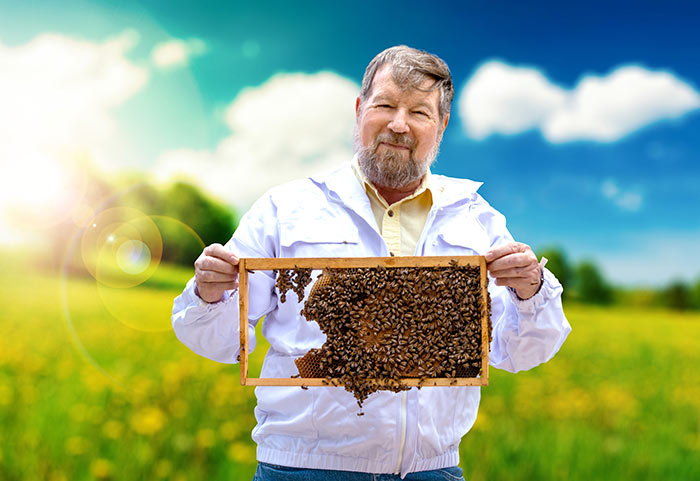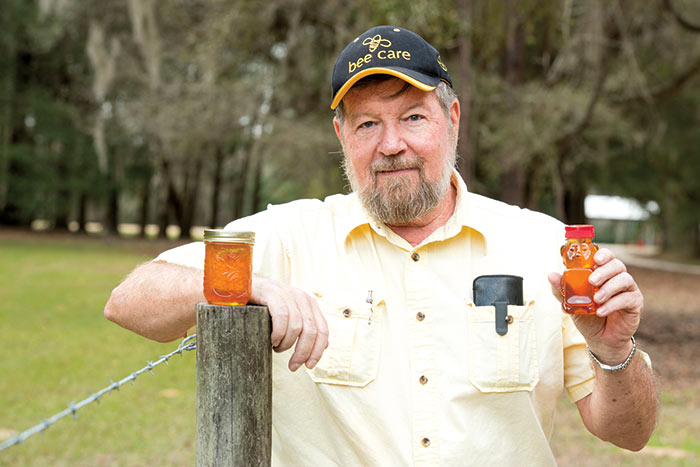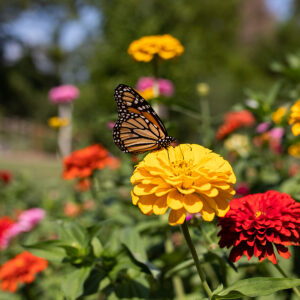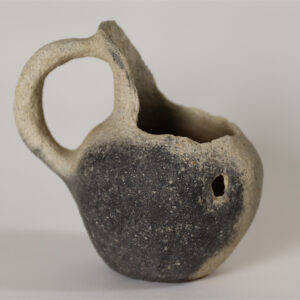
It’s a mild winter day, and I’m standing in an apiary in Alachua, Florida, wearing the traditional beekeeper’s suit and hood. Thousands of honeybees are humming around me as they go about their business in a dozen or so hives.
Beekeeper Chappie McChesney puffs a small cloud of smoke from his hand-held smoker into the opening atop one of the wooden hive boxes and then gently pries open the lid. Inside, a thick layer of bees are working industriously.
I’ve always heard that the smoke calms the bees, making them less apt to sting. McChesney says the truth is that the bees just get busier fanning in an effort to clear the smoke.
“Just like you’d get busy if your house suddenly filled with smoke,” he says with a smile.
He taps the frame on the hive, and most of the bees fall off, giving us a better look at the results of their labor. The frame is three-quarters filled with comb they’ve built, and many of the tiny six-sided compartments are sealed over with wax.
At McChesney’s urging, I press a finger against this wax, breaking it open. Rich, golden honey seeps out. I press my honey-soaked finger to my mouth, tasting pure, raw sweetness.
Seems I’ve come to the right place to learn about bees.
When I started researching my story, I heard from area beekeepers that the person I had to talk to was McChesney. He’s been called a “bee whisperer” and the “bee guru” in these parts. I suspected he’d have more knowledge and information than I could possibly use for one story, and I was right.
Now 69, McChesney has been working with bees for most of his life. It all began the summer he was 7 years old and pushed over a neighbor’s beehive. Not only did he get seriously stung, but his father, in an effort to teach his young son a lesson, forced him to work all summer for that neighbor beekeeper.
“I’ve been at this a long time, and I still learn something new every day,” he says. “I don’t think you ever really ‘master’ it.”

Dangerous Times
The honeybees we rely on for honey production in the United States weren’t native to North America. They are European honeybees, first brought to the New World by settlers in the early 1600s.
And it’s a good thing they’re here.
According to the United States Department of Agriculture (USDA), “More than three-fourths of the world’s flowering plants rely on pollinators, such as bees, to reproduce, meaning pollinators help produce one out of every three bites of food Americans eat.”
Some specialty crops are wholly dependent upon honeybees for pollination. Each year, California’s almond industry uses 1.4 million colonies of bees. That means as much as 60 percent of all managed honeybee colonies in the country are trucked to California for pollination services.
You read that right. Commercial beekeepers load up thousands of hives and haul them to sites where farmers rent the use of their bees for a specified amount of time so they can pollinate crops. It’s big business; commercial beekeepers make a significant income in just a few weeks’ time. (Tractor trailers loaded with hives are covered with netting to contain any bees that fly out of the hives during transport or at rest stops.)
Here in Florida, the number of beekeepers and hives is on the rise. This is good news for bees, which face serious threats to survival. Our modern world is a dangerous place for bees, whose numbers have significantly declined.
In the 1940s, there were about 5 million managed honeybee colonies in the United States. Today, that number is barely 2.5 million.
From 2006 to 2011, U.S. beekeepers reported average losses of 33 percent each year. Some had losses as high as 90 percent. Experts warn that if such staggering losses continue, it would endanger the economic viability of the entire bee pollination industry, resulting in increased food costs as farmers must pass on the rising costs of producing crops.
A third of those losses were attributed to colony collapse disorder (CCD), which has been an alarming problem for beekeepers, especially over the past decade. This occurs when a colony has a live queen but no surviving adult bees, even though honey and immature bees may still be present. Studies continue to find that neonicotinoid pesticides are to blame for the increase in hive mortality rates. Neonicotinoids are a relatively new class of insecticides, and, as the name implies, they are chemically related to nicotine. Farmers can apply these water-soluble insecticides to the soil, where they are taken up by the plants. Although neonicotinoids are much less toxic to birds and mammals, they are deadly to insects, including bees.
“Farmers spraying chemicals kill not just bees,” says McChesney, “but anything that pollinates plants.”
McChesney is dismayed at the loss of bees due to such insecticides, but it’s not just farmers applying chemicals to crops that harm bees. Many beekeepers themselves use chemicals to treat their hives, something McChesney, who teaches chemical-free beekeeping, is absolutely against.
“A lot of experts think you have to treat bees with chemicals or they won’t last two years, but you can keep your bees alive much longer than that without poisoning them,” he notes. “Anything you put in your hive is going to be in your honey. A lot of the honey you buy in stores is full of toxins.”
McChesney points out that 50 years ago beekeepers didn’t have to worry about the same type of chemicals, but they also weren’t facing the same threats today’s beekeepers struggle with.
For example, many scientists say that varroa mites are one of the biggest threats to modern bees. Aptly known as varroa destructor, this tiny parasite, which first became recognized as a problem in the 1990s, can only reproduce in a honeybee colony. The mites attach to the bee’s body, sucking its hemolymph (the fluid in invertebrates similar to blood). In some cases, multiple mites will attach to a single bee. If the infestation is significant, it can lead to death of the entire bee colony.
Understandably, beekeepers want to prevent this, so many of them treat their hives with chemicals.
“Basically, they’re using chemicals to kill small insects on a larger insect, but they’re still using toxins in the hive,” explains McChesney, who instead uses small oil-filled traps in his hives to catch small hive beetles and powdered sugar to dust off varroa mites. “The more chemicals you use, the more resistant the pests become and the weaker the bees become,” he adds.
One of the ways that insect pests, like varroa mites and more, get into hives is when beekeepers rent out their hives to farmers, he adds. The bees can pick up pests and diseases from this area, and when the beekeepers come to transport their hives back home, they’re bringing those diseases and pests with them.
A Busy World
Spring and fall are the busiest seasons for beekeepers in Florida.
This is often when McChesney gets calls from firemen and homeowners to come capture swarms of bees.
“Bees will swarm whenever a hive has more than one queen. It’s a natural thing. The bees don’t need to be killed. I’ll go and capture the swarm in a box and bring them back to my place,” he says. “I’ve also been called to houses where bees have made a hive in the walls, and I’ve rescued them.”
Another common reason swarms will form is when a tractor-trailer loaded with commercial hives pulls into a truck stop. Truckers routinely stop to cool down the hives, and even though there’s a net covering the trailer, it’s not unusual for that netting to get torn. If bees escape, they’ll usually just hang in a swarm at the truck stop. When McChesney gets a call like this, he gets to the scene as quickly as possible in hopes of rescuing the bees before authorities come in and kill them.
Rescued bees quickly settle into a hive and get down to business, which is all about reproducing and making honey. In summertime, a honeybee’s life span is just about 21 to 35 days—and that’s if nothing out of the ordinary happens to it. The queen is an exception and can live for several years.
“A hive is really a democracy ruled by the female bees, and only females work,” says McChesney. During her short lifespan, each average honeybee worker makes 1/12th a teaspoon of honey.
The hive consists of three wooden boxes. The top box, known as a “super,” is where the bees make and store honey. The bottom two boxes are referred to as “deeps” and are home to the larvae and developing bees.
That old saying “busy as a bee” rings true. Worker bees do just that: work non-stop. They’ll travel up to 5 miles from their hive in search of pollen and nectar. The bee’s entire body is covered by branched hairs, which build up a static charge as the bee flies; this causes the pollen to stick to them. Once bees get back to the hive, they rake the pollen off with their comb-like legs.
The worker bees store the pollen in cells after adding a little nectar and enzymes, which help break the pollen down into what beekeepers refer to as “bee bread,” a protein-rich food that they feed to the developing larvae.
Although everything revolves around the queen, she doesn’t “rule” the hive. The queen bee mates with 20 to 25 drones, and the drones die afterward. The queen’s job is to populate the hive, and she does this by laying eggs—as many as 2,000 to 3,000 in one day, or an average of one every minute or so.
Pheromones are a crucial part of hive life. When a queen gets old or weak, she is no longer putting off strong pheromones, and the worker bees know it’s time to make a new queen. They do this by choosing several larvae and feeding them nothing but royal jelly, which is secreted from glands in the worker bees’ heads. (Actually, all bee larvae get fed royal jelly for the first few days, but only larvae destined to become queens continue to receive it as their total nutrition source.) It takes 16 days for a virgin queen to develop from larvae and emerge.
As McChesney notes, this is definitely a case of “you are what you eat.”

Honey Production
In the natural world, bees make and store honey to get them through a long winter or times when food sources are not available. When humans enter the picture, we take that honey for ourselves, but a wise beekeeper always leaves enough honey in the hives so the bees don’t starve.
The nectar that later becomes honey starts out as predominately water, as much as 80 percent. Bees place the nectar in hive cells, adding enzymes to it. They dry the nectar down to around 17 percent moisture by fanning their wings over it and passing droplets between each other to get the moisture out. When the moisture content is low enough, they cap it off, and it is now ripe honey. Hive and weather humidity can affect the time it takes to dry honey.
Honey-filled supers full of frames of capped honey are removed from the hive and placed in a drying room to help keep the moisture content down, since honey absorbs moisture from the air. The frames are then processed by uncapping the cells and spinning out the honey in an extractor.
“Honey will vary in color from water-white to dark as molasses depending on the floral source the bees are collecting the pollen and nectar from,” notes McChesney. “All raw honey contains some pollen, although the grains are so small you usually can’t see them.
“Honey won’t spoil, but it will crystallize if it’s older,” he adds. “If this happens, just set the jar in a pan of warm—not hot—water until the honey liquefies. Don’t heat it, because this kills the enzymes and all the good things nature put into it.”
Stung?
Here’s What to Do
Although your instinct is to grab it and pull, don’t! Instead, scrape the stinger off with something firm, like the edge of a credit card or a flat edged object. Grabbing it or using tweezers just pushes more of the venom into your body. Ice the area. Apply calamine lotion if it itches. If pain persists, ibuprofen or acetaminophen may be helpful.
Just so you know, when a bee stings you, it’s the end of her life. A bee’s stinger is made of two flat, serrated blades; the bee can’t pull it out of something once she’s stung it. When she leaves that little pouch with the stinger embedded in your skin, she soon dies. So, you may be hurting, but she’s worse off.
You can Help Bees!
Do your part to fight the decline of honeybees. You can help make a difference right in your own yard. Here’s how:
Educate your children about the importance of honeybees.
Don’t kill bees when you see them.
Buy honey from local beekeepers.
Avoid or limit use of insecticides and herbicides unless absolutely necessary, and avoid spraying during mid-day when bees are most active.
Provide bee habitat, such as bushes, trees and plants, as opposed to open grass areas, which is like a desert for bees because there’s nothing to eat!
Plant a pollinator garden.
What’s a “pollinator garden,” you ask? It includes:
Plants, preferably native, that flower at different times of the year and provide nectar and pollen for different pollinators (bees, bats, hummingbirds, butterflies, etc.)
Planted in clumps, rather than spaced out
Variety of flower colors and shapes
To find out what’s best to plant in our area, go to pollinator.org and click on “Planting Guides.”
Calling All Would-Be Beekeepers!
If you have any interest in keeping bees—or just want to learn more about them—education is the first step. Sign up for the Beginner’s Beekeeping Class taught by Chappie McChesney. This free two-hour class is held at On Top of the World. The class covers all aspects of beginning beekeeping, including necessary equipment and costs involved. There’s time for a Q&A, and you’ll get a first-hand look at the hives on-site. Contact Chappie McChesney at (386) 462-2637 or chappiesbees@windstream.net or visit masterthepossibilities.com/online-catalog.php.
Learn More
facebook.com/chappie.mcchesney
floridabeekeepers.org
facebook.com/marioncountybees





